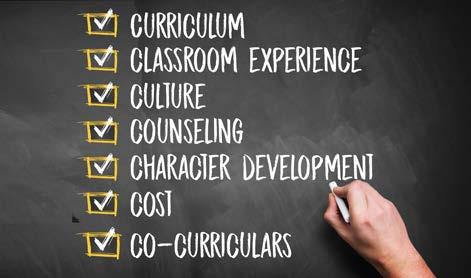
6 minute read
Curriculum
Curriculum
Let’s start with the centerpiece of a good education - the curriculum. The state of California sets the instructional minutes and the standards for core curriculum, so a curriculum that offers your student plenty of enrichment is what can really distinguish your child’s educational experience.
In the early years, popular enrichment options include choir, orchestra, art, coding, robotics, foreign language, and at faithbased schools, religion. But if you’ve toured a few schools, you may have noticed a disparity in offerings among schools, in both the public and private arena.
Some schools gain extra classroom time through a strategic master schedule, use of zero period, or by keeping P.E. time to the state-mandated minimum. And some schools just run a longer school day.
Pay attention to not only what enrichment opportunities a school is offering, but to how much instructional time is devoted to these activities and where that additional instructional time is coming from.
In middle school, vertical alignment of the curriculum becomes important. A school that allows your child to pack in a year or two of high school level foreign language or accelerate to a higher-level math course clears the deck for more rigor and electives in high school. This is important from a college admissions standpoint.
In high school, it’s all about a course of study that allows students to develop their interests, nurture their passions, and distinguish themselves as a college applicant. CTE pathways, embedded academies and conservatories, along with dual enrollment, honors, and advanced placement coursework are key to these objectives.
Access to desired courses can be limited by a school’s poorly designed master schedule or because of overly restrictive pre-requisite requirements. Drill down on what coursework is offered, and whether electives and opportunities are available to more than just a small number of students.
Classroom Experience
The classroom is where the rubber meets the road, so finding the right learning environment for your student is an essential aspect of school selection. The traditional classroom has given way to an abundance of new instructional models that benefit different types of learners, such as project-based learning, experiential learning, inquiry-based learning, adaptive learning, differentiated instruction, a flipped classroom, and more.
Fortunately, area public, charter, and private schools offer an array of instructional models that can meet many different learning styles, preferences and needs. What works well for one student may not work for another, and so knowing how your child learns best is the driver here.
A school’s homework expectations and grading practices are also important factors to consider. While standards based grading (also known as mastery based learning) is the norm in elementary schools, it can also be found in more progressive middle and high schools. Standards based grading typically allows for test corrections, ungraded homework, and overall more flexibility for the student as opposed to traditional grading practices.
And still, it may simply come down to the right teacher fit. To this end, ask what factors the school considers when matching up teachers and students and whether your input will be considered.
Culture
A school’s culture is reflected in its core values, traditions, and interactions with students and their families. Culture is key to a school’s success and to positive student outcomes. It is more than words in a mission statement. It is an ethos that is engrained in the mindset of faculty and staff and practiced both inside and outside the classroom.

Minimally, a school’s culture should set high expectations for students, staff, and faculty alike, embrace parents as important partners in the educational setting, and reflect unwavering commitment to diversity and equity.
Counseling
A skilled counseling staff goes a long way toward helping students realize their potential. For starters, counselors and school psychologists can help identify learning differences, the need for extra social-emotional supports, and help guide a student’s academic trajectory. Counseling staff also plays a key role in putting in place IEPs (individualized education plans) and 504 plans. For many students, these interventions are critical to their academic success and social-emotional well-being.
In high school, college advisement and course selection take center stage. Be sure to investigate how much help and expertise your student can count on in these areas.
Character Development
Not to be overlooked, character development is indeed an essential component of K-12 education. In recent years, it has also become increasingly important to college admissions officers. So much so, that a growing number of universities and colleges nationwide have joined the Harvard Graduate School of Education’s “Making Caring Common Project,” formally integrating character assessment into their college admissions process.
For K-12 schools, character development often coalesces with a school’s culture, and so you will find a variety of focus areas. For some schools, it might be environmental stewardship and global citizenship, at others, community service and social responsibility. Other schools may focus on students’ intrinsic qualities, such as

leadership, compassion and empathy, resilience and grit, or commitment to equity and justice.
Whatever the focus, the gains are only realized when the framework is threaded throughout the school’s endeavors and reinforced with meaningful actions. Be sure to understand how the school you’re considering goes about this important aspect of your child’s development.
Cost
Everything has a price, and your child’s education is no different, regardless of whether public or private school is in play. To be sure, comparing school costs is not as easy as just comparing the tuition. The comprehensiveness of public, charter, and private educational programs vary markedly.
Public school parents should carefully consider how much they will have to supplement their child’s education with extracurricular enrichment activities, extra tutoring, and college
counseling, as well as what they will be expected to contribute toward extended class trips, field trips, and other student enrichment experiences.
Private school tuition can vary considerably in price as well as in what the tuition covers. Consider what perks, services, and supports the tuition covers, whether it’s smaller class sizes, learning support, robust college counseling support, or more enrichment electives and activities. In light of what your student may be getting, private school tuition can be good bang for the buck.
Co-curriculars
What would the K-12 years be like without school plays, Friday night football, yearbook, speech and debate tournaments, and the full complement of athletics, student clubs, dances, and affinity groups?
Co-curriculars are where students practice leadership, teamwork, and social skills, while building self-esteem and a sense of belonging. They are also what your student will look back on as the defining moments and memories of their iconic childhood and high school years.
Some schools do better than others in facilitating engagement and fostering a climate of support for these student-driven endeavors. Investigate how school plays are cast and how athletic teams are chosen and the caliber of staff responsible for overseeing these endeavors.
Learn More....
For more about character in college admissions:
https://mcc.gse.harvard.edu/resources-for-colleges/character-assessment-college-admission-guide-overview
https://www.insidehighered.com/admissions/views/2019/11/04/character-difficult-define-important-admissions-opinion
For more about the role of co-curricular activities:
https://idreamcareer.com/blog/importance-of-co-curricular-activities-for-students/
A WellSchooled Tip.....
Missed out on this application round? Some schools have a rolling admissions policy and will consider your child’s application throughout the year. And even when a rolling admissions policy isn’t in place, it’s not uncommon for a school to consider applications after the fact. It never hurts to ask!

